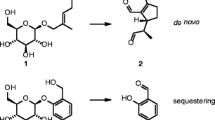Abstract
Two phenolic acids were identified in the collembolan Ceratophysella denticulata: 3-hydroxy-4,5 dimethoxy benzoic acid and 4-hydroxy-3,5-dimethoxybenzoic acid (syringic acid). These are localized on or in the integument of the springtail, in field-collected animals, in a ratio of 47:100 (v/v). Springtails kept under different temperature regimes showed differences in production and ratio of the benzoic acid derivatives. At 20°C, C. denticulata produced only syringic acid, whereas at 10°C both isomers in a ratio of 100:61 (v/v) were detected. Bioassays with C. denticulata as well as with the specialized collembolan predator Stenus comma (Staphylinidae) were carried out. Staphylinid beetles topically treated with the acids try to clean their mouthparts by rubbing them on the ground significantly more often than do control beetles. Both compounds individually and as a natural mixture have deterrent effects towards the predator S. comma.
Similar content being viewed by others
REFERENCES
Adams, C.M. and Bernays, E. A. 1978. The effect of combinations of deterrents on the feeding behavior of Locusta migratoria. Entomol. Exp. Appl. 23:101-109.
Altner, H. and Thies, G. 1973. A functional unit consisting of an eversible gland with neurosecretory innervation and a proprioreceptor derived from a complex sensillum in an insect. Z. Zellforsch. 145:503-519.
Aziz, N. H., Farag, S.E., Mousa, L. A. A., and Abo-Zaid, M. A. 1998. Comparative antibacterial and antifungal effects of some phenolic compounds. Microbios 93:43-54.
Bauer, T. and Pfeiffer, M. 1991. “Shooting” springtails with a sticky rod: The flexible hunting behavior of Stenus comma (Coleoptera: Staphylinidae) and the counter-strategies of its prey. Anim. Behav. 41:819-828.
Betz, O. 1998. Comparative studies on the predatory bahaviour of Stenus spp. (Coleoptera, Staphylinidae): The significance of its specialized labial apparatus. J. Zool. Lond. 244:527-544.
Dettner, K., Scheuerlein, A., Fabian, P., Schulz, S., and Francke, W. 1996. Chemical defense of giant springtail Tetrodontophora bielanensis (Insecta: Collembola). J. Chem. Ecol. 22:1051-1074.
Eriksson, K.-E., Gupta, J. K., Nishida, A., and Rao, M. 1984. Syringic acid metabolism by some white-rot, soft-rot and brown-rot fungi. J. Gen. Microbiol. 130:2457-2464.
Harris, J.R.W. and Usher, M. B. 1976. Laboratory studies of predation by the grassland mite Pergamasus longicornis Berlese and their possible implications for the dynamics of populations of collembola. Sci. Proc. Royal Dubl. Soc., Ser. A 6:143-153.
Hodgson, J.M., Morton, L.W., Puddey, I.B., Beilin, L.J.,and Croft, K. D. 2000. Gallic acid metabolites are markers of black tea intake in humans. J. Agric. Food Chem. 48:2276-2280.
HOPKIN, S. P. 1997. Biology of the Springtails (Insecta: Collembola). Oxford University Press, 330 pp.
Howard, R.W. and Bolmquist, G. J. 1982. Chemical ecology and biochemistry of insect hydrocarbons. Annu. Rev. Entomol. 27:149-172.
Joosse, E.N.G. and Koelman, T. A. C. M. 1979. Evidence for the presence of aggregation pheromones in Onychiurus armatus (Collembola), a pest insect in sugar beet. Entomol. Exp. Appl. 26:197-201.
Jutsum, A.R. and Gordon, R. F. S. 1989. Insect Pheromones in Plant Protection. Wiley, Chichester, 369 pp.
Klinke, H.B., AHring, B. K., Schmidt, A. S., and Thomsen, A. B. 2002. Characterization of degradation products from alkaline wet oxidation of wheat straw. Biores. Technol. 82:15-26.
Kovacik, V., Skamla, J., Joniak, D., and Kosikova, B. 1969. Massenspektrometrie einiger Modell-substanzen des Lignins. Chem. Ber. 102:1513-1522.
Krauss, D., Mainx, H. G., Tauscher, B., and Bischof, P. 1985. Fragmentation of trimethylsilyl dervatives of 2-alkoxyphenols: A further violation of the “even-electron rule”. Org. Mass Spec. 20: 614-618.
Leinaas, H. P. 1988. Anal sacks—an unknown organ in Poduromorpha (Collembola). Zool. Scripta 17:277-284.
Manica, A., McMeechan, F. K., and Foster, W. A. 2001. An aggregation pheromone in the intertidal collembolan Anurida maritima. Entomol. Exp. Appl. 99:393-395.
Messer, C., Dettner, K., Schulz, S., and FranckE, W. 1999. Phenolic compounds in Neanura muscorum (Collembola: Neanuridae) and the role of 1,3-dimethoxybenzene as an alarm substance. Pedobiologia 43:174-182.
Messer, C., Walther, J., Dettner, K., and Schulz, S. 2000. Chemical deterrents in podurid Collembola. Pedobiologia 44:210-220.
Nelson, D.R. and Blomquist, R. J. 1995. Waxes: Chemistry, molecular biology and functions, pp. 1-90, in R. J. Hamilton (ed.). Insect Waxes. The Oily Press, Dundee.
Paclt, J. 1956. Biologie der primär flügellosen Insekten. Gustav Fischer, Jena, 258 pp.
Panic, J. 1963. Das Verhalten von Ameisen gegenüber bodenbewohnenden Kleinarthropoden. Pedobiologia 2:223-224.
Purrington, F.F., Kendall, P. A., Bater, J.E., and Stinner, B. R. 1991. Alarm pheromone in a gregarious poduromorph collembolan (Collembola: Hypogastruridae). Great Lakes Entomol. 24:75-78.
Schulz, S. 2001. Selectivity in chemical communication systems of arthropods, pp. 237-252, in F. G. Barth and A. Schmid (eds.). Ecology of Sensing. Springer, Berlin.
Tuncel, G. and Nergiz, C. 1993. Antimicrobial effect of some olive phenols in a laboratory medium. Lett. Appl. Microbiol. 17:300-302.
Vannier, G. 1971. Les fourmis, prédateurs permanents de certains types de collemboles. Rev. Écol. Biol. Sol. VIII:119-132.
Verhoef, H. A. 1984. Releaser and primer pheromones in collembola. J. Insect Physiol. 30:665-670.
Verhoef, H. A., Nagelkerke, C.J., and Joosse, E. N. G. 1977. Aggregation pheromones in Collembola (Apterygota): A biotic cause of aggregation. Rev. ´Écol. Biol. Sol. 14:21-25.
Walsh, M.I. and Bolger, T. 1990. Effects of diet on the growth and reproduction of some Collembola in laboratory cultures. Pedobiologia 34:161-171.
Wilson, E. O. 1950. Notes on the food habits of Strumigenys louisianae (Hymenoptera: Formicidae). Bull. Brookl. Entomol. Soc. XLV:85-86.
Author information
Authors and Affiliations
Rights and permissions
About this article
Cite this article
Bitzer, C., Brasse, G., Dettner, K. et al. Benzoic Acid Derivatives in a Hypogastrurid Collembolan: Temperature-Dependent Formation and Biological Significance as Deterrents. J Chem Ecol 30, 1591–1602 (2004). https://doi.org/10.1023/B:JOEC.0000042070.99126.b9
Issue Date:
DOI: https://doi.org/10.1023/B:JOEC.0000042070.99126.b9




